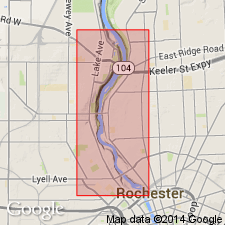
- Usage in publication:
-
- Kodak white sandstone
- Modifications:
-
- Named
- Dominant lithology:
-
- Sandstone
- AAPG geologic province:
-
- Appalachian basin
Summary:
Name Kodak white sandstone is introduced to replace "gray band" in Genesee Gorge at Rochester, which was formerly called, by writer and others, Thorold sandstone, but which is now known to be younger than true Thorold sandstone of Niagara Gorge, and of Clinton age. Type exposure in lower Genesee Gorge from the lower falls to Kodak Park, Rochester.
Source: GNU records (USGS DDS-6; Reston GNULEX).
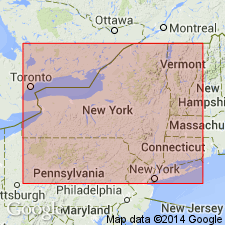
- Usage in publication:
-
- Kodak
- Modifications:
-
- Not used
- AAPG geologic province:
-
- Appalachian basin
Summary:
Author states that Chadwick (1935) was of the opinion that Thorold sandstone was absent at Rochester because grayish-white sandstone there did not contain ARTHROPHYCUS, which he regarded as indicative of the Thorold. To this presumably younger sandstone beneath the Maplewood shale he applied name Kodak white sandstone. There is no necessity for name Kodak because ARTHROPHYCUS has since been found in this sandstone at Rochester.
Source: GNU records (USGS DDS-6; Reston GNULEX).
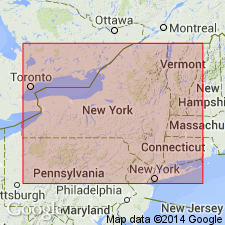
- Usage in publication:
-
- Kodak sandstone
- Modifications:
-
- Reinstated
- AAPG geologic province:
-
- Appalachian basin
Summary:
Because "Thorold" of Gillette (1947) is not continuous with type Thorold at Thorold, Ontario, name Kodak of Chadwick is revived for basal sandstone of Clinton group in NY. Age is Middle Silurian.
Source: GNU records (USGS DDS-6; Reston GNULEX).
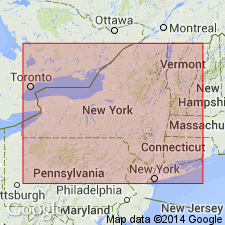
- Usage in publication:
-
- Kodak Formation
- Modifications:
-
- Revised
- AAPG geologic province:
-
- Appalachian basin
Summary:
The Medina Group comprises 11 facies, which can be organized into three facies associations. The previously defined color-based formations do not conform with lithic correlations except for the Whirlpool and Manitoulin. A formal major revision is being proposed by Brett and others (in press) and Duke and others (in press). The newly revised Medina Group will include the Whirlpool Sandstone at its base (virtually unchanged), the overlying Jolley Cut Formation (a tentative renaming of the Manitoulin), the Balls Falls Formation (new), the Art Park Phosphate Beds (new), the Devils Hole Formation (new), the Grimsby Formation (revised), the Power Glen Formation (revised), the Thorold Formation (revised), the Cambria Formation (new), and the Kodak Formation (resurrected), which caps cycle G. The Medina unconformably overlies Queenston Shale; unconformably underlies Clinton Group. (See Brett and others, in press, and Duke and others, in press, for more detailed revision.)
Source: GNU records (USGS DDS-6; Reston GNULEX).
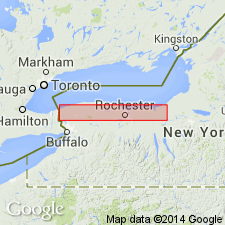
- Usage in publication:
-
- Kodak Sandstone
- Modifications:
-
- Revised
- AAPG geologic province:
-
- Appalachian basin
Summary:
Thorold Sandstone should not be included as the basal unit of the Clinton Group, as the Thorold is found below the basal Clinton unconformity westward from Niagara Co., NY, to St. Catharines, Ontario. Eastward from Niagara Co., the units overlying the Thorold and underlying the Clinton include the 2.0- to 3.0-m-thick reddish, ostracode-bearing Cambria Shale and the 2.0- to 5.0-m-thick greenish to slightly reddish gray Kodak Sandstone. The Kodak underlies the Webster Bed (new) in Wayne Co., and the Densmore Creek Bed (new) in Monroe Co., both of which mark the base of the Clinton. The Thorold, Cambria, and Kodak are conformable with one another and therefore are included in the uppermost Medina Group.
Source: GNU records (USGS DDS-6; Reston GNULEX).
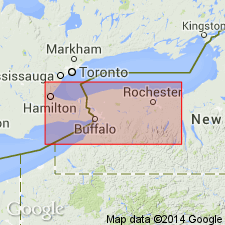
- Usage in publication:
-
- Kodak Sandstone*
- Modifications:
-
- Overview
- AAPG geologic province:
-
- Appalachian basin
Summary:
The Kodak Sandstone of the Medina Group in western NY consists of medium-gray to white, argillaceous, quartzose sandstone. Thickness is 5 to 11 ft. Unit is uppermost formation of Medina Group. Overlies the Cambria Shale of the Medina Group and unconformably underlies the Neahga Shale of the Clinton Group. The Kodak is of Early Silurian (early Llandoverian) age based on ostracodes. [Report uses Early and Late Silurian time scale of Harland and others (1982).]
Source: GNU records (USGS DDS-6; Reston GNULEX).
For more information, please contact Nancy Stamm, Geologic Names Committee Secretary.
Asterisk (*) indicates published by U.S. Geological Survey authors.
"No current usage" (†) implies that a name has been abandoned or has fallen into disuse. Former usage and, if known, replacement name given in parentheses ( ).
Slash (/) indicates name conflicts with nomenclatural guidelines (CSN, 1933; ACSN, 1961, 1970; NACSN, 1983, 2005, 2021). May be explained within brackets ([ ]).

